
Of all the U.S. military programs facing elimination, the V-22 Osprey program is most deserving. The MV-22 is far too expensive and too unstable to conduct combat assaults. The February issue of G2mil contains an article "The V-22 Fiasco" which should convince any sane person that this program is deeply flawed. An April 20, 2001 report by POGO summarizes other MV-22 problems. Early this year, a "blue-ribbon" panel consisting of a retired Marine General and two defense industry insiders was convened to ensure continuation of this program. This bogus review panel traveled the nation to visit manufacturing plants where the flawed MV-22s were built, but didn't find time to drive one hour outside Washington DC to talk with the MV-22 test pilots based in Maryland.
The panel recommended that obvious technical problems should be fixed, and an expensive redesign is now underway. The lightweight titanium hydraulic lines are too thin, so they will be replaced. Proper testing should eliminate the software problems. The Bell-Boeing team became aware of these problems during testing, but never fixed them, and 20 Marines died as a result. In private business, Bell-Boeing would have paid millions of dollars to the families of the dead Marines. They would also be expected to fix flaws in a product they produced, but in the corrupt world of U.S. military contracting, they will be paid even more money. The Marines also want a .50 caliber gatling gun mounted, so this will further complicate matters.
Meanwhile, the production line will stay open to produce incomplete MV-22s, which will be parked until the redesign work is finished. Then another billion dollars will be wasted to modify these 40 or more pre-production lemons. This redesigned MV-22C should be ready to fly within a year, but will it be thoroughly tested as promised? This would cost another billion dollars, take another two years, and may identify more problems. As a result, Marine Generals may claim that the redesigned Osprey was already tested. The MV-22s will be delivered to operational squadrons where pilots will face ridiculously stringent flight limitations to prevent another accident. This is of little concern to the racketeers at Bell-Boeing and in the U.S. Congress. Their goal is to produced as many MV-22s as possible, and then collect billions more dollars to continually "fix" problems. They will never admit that the MV-22's design is fundamentally flawed, and will continue to look reporters and Congressmen in the eye and repeat these lies.
#1 The MV-22 has twice the range of helicopters.
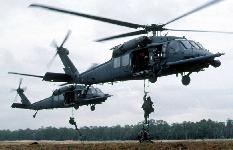 The MV-22 has about the same range as
modern helicopters, like the new Navy MH-60S. The Marine Corps' old CH-53E
has twice the range of the MV-22, which can be verified at the Marine
Corps' own website. In those rare cases when the Marines need
to fly long distances for a raid, the MH-60S can be equipped with external
fuel tanks and far outrange the MV-22. The Special Operations command
already operates the MH-60G "Pavehawk" (right) with a range of 445 nautical
miles, almost twice the range of the MV-22. The MV-22 has "indefinite"
range if refueled in the air, but helicopters can be fitted with booms to refuel in the air too.
The MV-22 has about the same range as
modern helicopters, like the new Navy MH-60S. The Marine Corps' old CH-53E
has twice the range of the MV-22, which can be verified at the Marine
Corps' own website. In those rare cases when the Marines need
to fly long distances for a raid, the MH-60S can be equipped with external
fuel tanks and far outrange the MV-22. The Special Operations command
already operates the MH-60G "Pavehawk" (right) with a range of 445 nautical
miles, almost twice the range of the MV-22. The MV-22 has "indefinite"
range if refueled in the air, but helicopters can be fitted with booms to refuel in the air too.
#2 The MV-22 has twice the speed of helicopters.
The MV-22 can reach 240 knots, while helicopters are limited to around 148 knots, so its about 62% faster, not 100%. Even the 40-year old CH-46 can fly 145 knots. If the MV-22 carries cargo on an external hook, it must keep its rotors upright and cannot fly any faster than helicopters.
#3 The MV-22's higher speed makes it safer from ground fire.
Obviously,
a faster flying aircraft is harder to hit. However, helicopter transports
flying over enemy territory are normally escorted by Cobra attack helicopters. The
armored Cobras scout ahead and engage threats, and guide the transports away
from dangers. The Cobras also stand guard over the landing zone to immediately
engage threats. 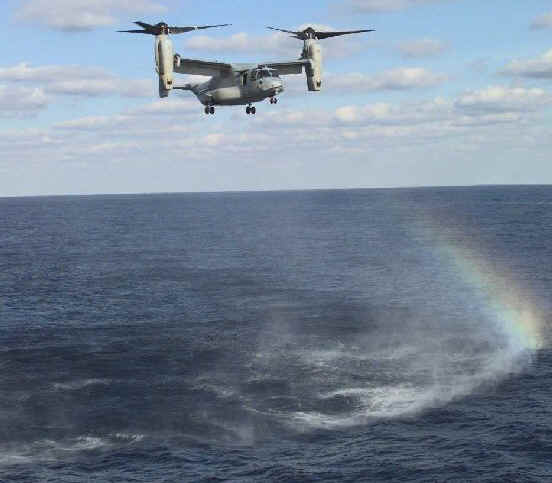 Many Marines have questioned if Ospreys
will operate without escorts, or fly at helicopter speeds so the Cobras can
keep up. (see the April issue of the Marine Corps Gazette)
This important issue has been ignored by Marine Generals.
Many Marines have questioned if Ospreys
will operate without escorts, or fly at helicopter speeds so the Cobras can
keep up. (see the April issue of the Marine Corps Gazette)
This important issue has been ignored by Marine Generals.
The biggest danger assault transports face is in the landing zone. To avoid a deadly loss of lift called "vortex ring state" MV-22s must descend at half the rate of helicopters. In addition, the MV-22s generate three times more "downwash" as they land, so the danger of damage from flying debris among a group of MV-22 is higher. The 90knt downwash is so strong (see photo) that sea rescues are dangerous and landing in the desert causes a "brown out" where visibility is zero. The wind is so strong and the flying debris so dangerous that landed troops must lie down in exposed fields until the MV-22s fly away.
Survivability is an even bigger issue. Helicopters can land after a loss of engine power, by using "autorotation", the MV-22s rotors are too small, which is why unusual "test waivers" were allowed. Minor damage to the MV-22 rotors or complex drive system can cause catastrophic results, as the first two MV-22 crashes demonstrated. The two rotors must work perfectly in tandem, otherwise the imbalance causes the MV-22 to roll over, as the third and fourth crashes demonstrated. Finally, if the rotors become stuck forward, the MV-22 cannot land anywhere because its rotor blades extend well below the fuselage. During the Vietnam War, damaged helicopters landed safely thousands of times; damaged MV-22s just fall out of the sky.
#4 The MV-22 can carry 24 combat equipped Marines.
The MV-22 is supposed to carry as many Marines as the CH-46E, but its cargo compartment is almost four feet shorter, and slightly narrower. Nevertheless, the Marine Corps insists the MV-22B can carry 24 combat-equipped Marines, even after the GAO determined that only 15-18 Marines will fit. Remember that 19 Marines died when the MV-22 flipped over during the April 11, 2000 full operational evaluation (e.g. 4 crewmen and 15 troops).
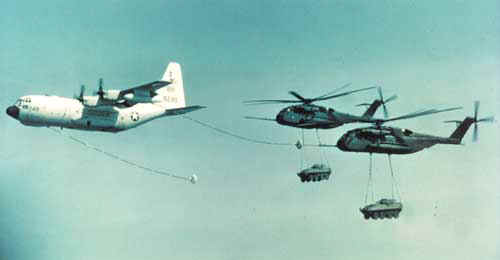 The "requirement" that a new Marine helicopter must carry 24 Marines
was invented in someone's head, it is not based on a real need. A
requirement to lift a certain artillery gun or vehicle is valid, but the exact
number of troops is an elastic standard. If moving the maximum number of
bodies is the goal, the Marine CH-53E (right) can carry 55 Marines, or an armored
vehicle.
Articles have appeared in professional journals which argue that the Corps
should forward-deploy composite squadrons consisting of 10 powerful CH-53Es and
4 CH-46Es, rather than 12 CH-46Es and 4 CH-53Es. This mix could double the
squadron's helicopter lift, but this idea was ignored because it would
threaten justification for the MV-22 program.
The "requirement" that a new Marine helicopter must carry 24 Marines
was invented in someone's head, it is not based on a real need. A
requirement to lift a certain artillery gun or vehicle is valid, but the exact
number of troops is an elastic standard. If moving the maximum number of
bodies is the goal, the Marine CH-53E (right) can carry 55 Marines, or an armored
vehicle.
Articles have appeared in professional journals which argue that the Corps
should forward-deploy composite squadrons consisting of 10 powerful CH-53Es and
4 CH-46Es, rather than 12 CH-46Es and 4 CH-53Es. This mix could double the
squadron's helicopter lift, but this idea was ignored because it would
threaten justification for the MV-22 program.
#5 The MV-22 costs only $41 million each.
During this year (FY2001), Bell-Boeing was to receive $1208.5 million to produce 16 V-22 aircraft for the Marines, for an average cost of $76 million each. Some of this money was recently cut and reprogrammed for the redesign. The Marine Corps spent an average $90 million for each "pre-production" MV-22. The Department of Navy (which funds Marine Corps aviation) had budgeted around $66 million for each full-production copy, which is traditionally optimistic. Last year, the Navy determined the MV-22s costs had risen and cut the overall buy from 360 to 348. A GAO study last year estimated $83 million a copy, and that was before the Marines decided to add a gun and make other enhancements.
#6 It would take years to modify and test a modern helicopter like the Army's Blackhawk to operate from ships.
The new Navy MH-60S "Knighthawk" has already been fully tested and approved for full production. It can carry a crew of four and 13 passengers or 10,000lbs of cargo. The Marine Corps can simply sign a production contract to join in the Navy buy. Navy H-60 spare parts and training programs have been functioning for years, the Corps already operates eight VH-60s as part of the Presidential helicopter squadron. If the Corps joined the Army, Navy, and Air Force by adopting the Sikorsky H-60 series for basic transport, all services would save money and improve interoperability. This year, the Navy bought 17 MH-60S for $17 million each, they would cost even less if purchased at a higher rate with a joint Marine Corps buy. The MH-60S can carry almost as much as the MV-22, at one-sixth the price. The Navy is impressed with the MH-60S and plans to use them to replace their CH-46D helicopters, rather than buying 48 HV-22s.
Adopting the H-60 design would allow the Marine Corps to add a new capability by modifying some MH-60S as EH-60E electronic warfare aircraft, using components already in service with the Army. Another advantage is that the MH-60S is equipped to carry 16 Hellfire anti-tank missiles. This would quadruple the airborne anti-tank firepower of the Marine Corps. For example, composite squadrons which the Corps maintains forward-deployed include four Cobra attack helicopters which could be supported by 12 MH-60S carrying Hellfires and machine guns.
Another option is for the Corps to add the 43 MH-53E heavy lift helicopters which the Navy plans to retire. The Marines plan to upgrade and overhaul 101 of its fleet of 165 nearly identical CH-53Es to a CH-53F configuration, at a cost of $20 million each. Apparently, the funding drain of the MV-22 program will not allow all 165 CH-53Es to remain in service, even though they carry three times the cargo as the MV-22, and four CH-53Fs will cost less than one MV-22. Canceling the MV-22 would free ample funds to rebuild all Marine CH-53Es and Navy MH-53Es to provide 208 powerful CH-53Fs for the Marines.
#7 The MV-22 mishap rate is no worse than other new aircraft.
In a commentary in the February 12, 2001 issue of the Marine Corps Times, Steven Danyluk, a former Marine pilot now flying for American Airlines, wrote: "These accidents give the Osprey, which has barely 4,000 total flying hours, a mishap rate of nearly 100 per 100,000 flight hours, the statistical standard for measuring an airframe's safety record. The Marine Corps' overall safety record in 2000, excluding the MV-22, was 2.65 "Class A" mishaps per 100,000 flight hours. With MV-22 flights averaging two hours per mission, those riding aboard an Osprey have had, to date, a 1-in-500 chance of meeting a disastrous fate. If American Airlines operated with a similar mishap rate, it would suffer five crashes per day. Osprey advocates say high mishap rates are not uncommon with new designs. But the new designs that experienced such mishap rates primarily came at the dawn of the jet age, in aircraft that were mostly single-pilot configurations equipped with ejection seats. In contrast, the Osprey is designed to carry 24 combat-loaded Marines with no such escape mechanism."
FY96-00 Marine Class A Fght Mishap Rates
Data from the Navy Safety Center
|
Class A |
|||
|
Class A |
Flight Mishap |
||
|
Flight Hours |
Flight Mishaps |
Rate |
|
|
FY96 |
409,338 |
15 |
3.66 |
|
FY97 |
360,586 |
12 |
3.33 |
|
FY98 |
356,804 |
9 |
2.52 |
|
FY99 |
358,334 |
13 |
3.63 |
|
FY00 |
340,095 |
9 |
2.65 |
|
FY96-00 |
1,825,157 |
58 |
3.18 |
| MV22 | 4,000 | 4 | 100.00 |
The MV-22s mishap rate is actually worse because a "Class A" mishap is one where a death occurs or over one million dollars in damage is suffered, which is not difficult for aircraft which cost around $50 million dollars. For example, when a MV-22 flipped over and killed 19 Marines in April 2000, the other MV-22 in the flight also lost some control and suffered damage when it hit the runway hard. It may have suffered enough damage to qualify as "Class A". The four MV-22 crashes were total losses where everyone on board died, while most of the "Class A" mishaps in the chart were repairable damage.
Keep in mind that Marine aircraft average over 20 years of age, fly dangerous training missions in difficult weather, and are maintained by young Marines, often based overseas on ships. The new MV-22s have been flown only carefully scripted test missions, by the best pilots in the Corps, only in ideal weather, and under care of the Corps best mechanics. In contrast, none of the new C-17 aircraft have crashed, nor have any of the new F/A-18E. The F-22 had one mishap where the pilot ejected safely. The two other new military aircraft under development have suffered no mishaps; the RAH-66 Comanche helicopter and the Joint Strike Fighter.
#8 The MV-22 is essential for future Marine amphibious operations.
Throughout its history, the Marine Corps has conducted successful amphibious operations without the MV-22. Since the Navy is concerned about shore-based missile threats, the Marine Corps has embraced a concept of offloading ships from "over the horizon", which is about 25 miles offshore. Several studies has proven this impractical, including one from the Naval War College: Logistical Implications of Operational Maneuver From the Sea, which concluded "the Navy and the Marine Corps need to keep the laws of logistics in mind if they are to distinguish campaign plans from fanciful wishes." Even if major "over the horizon" landings becomes possible, the round-trip required for offload is less than 50 miles. The time needed to load and offload cargo, and refuel are the same for MV-22s as helicopters, which lessens the MV-22s advantage of greater speed, which applies only to internal loads. In any case, a CH-53E can shuttle far more cargo and troops 50 miles ashore each day than a MV-22.
The MV-22 program has gutted the Marine Corps
Historically, the Marine Corps has taken pride in a lean, mean, and economical Fleet Marine Force. During the 1980s, the Corps entered the world of developing expensive, complex weaponry, like the MV-22. The Corps has spent $12 billion "developing" the MV-22, which is more than it has spent on all other programs combined during its entire history. This money could have bought 1000 new helicopters, but has yet to produce a safe aircraft. The MV-22 was supposed to enter the fleet several years ago, but has been delayed as engineers struggle to "fix" problems.
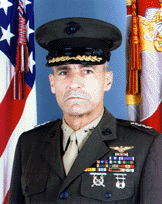 If the MV-22 was safe and cost $30 million each, it would be a great
contribution. Unfortunately, when fatal design flaws emerged several years
ago, Marine Generals refused to admit to a mistake, and committed the Corps
reputation to an impossible goal of fixing a fundamentally flawed aircraft.
The problems were hidden by applying heavy pressure on Marines involved in
testing and evaluating the MV-22 to lie. Even the editors of the "Marine
Corps Gazette" and Naval Institute "Proceedings" were intimidated
to censor negative comments about the MV-22 program or suggestions about alternatives. Mildly negative comments about the MV-22 in a formal JAG Manual investigation
report about the April 2000 crash were deleted by senior Marine
officers. Very few Marine Generals had any direct responsibly for the
MV-22 fiasco, but LtGen Fred McCorkle (left) deserves much blame.
As a Marine MV-22 pilot told the Washington Post, "people who were my
heroes all of my life are no longer my heroes."
If the MV-22 was safe and cost $30 million each, it would be a great
contribution. Unfortunately, when fatal design flaws emerged several years
ago, Marine Generals refused to admit to a mistake, and committed the Corps
reputation to an impossible goal of fixing a fundamentally flawed aircraft.
The problems were hidden by applying heavy pressure on Marines involved in
testing and evaluating the MV-22 to lie. Even the editors of the "Marine
Corps Gazette" and Naval Institute "Proceedings" were intimidated
to censor negative comments about the MV-22 program or suggestions about alternatives. Mildly negative comments about the MV-22 in a formal JAG Manual investigation
report about the April 2000 crash were deleted by senior Marine
officers. Very few Marine Generals had any direct responsibly for the
MV-22 fiasco, but LtGen Fred McCorkle (left) deserves much blame.
As a Marine MV-22 pilot told the Washington Post, "people who were my
heroes all of my life are no longer my heroes."
Marine Generals refuse to accept that hard work, billions of dollars, political clout, and lying cannot overcome the laws of aerodynamics. Billions of dollars in funding for Marine Aviation continue to flow down the Bell-Boeing rat hole as Marine Corps helicopter lift rapidly deteriorates. If the MV-22 program were cancelled today, the Marine Corps could immediately buy dozens of MH-60S helicopters each year "off-the-shelf" at a far lower cost and free funds for a fleet of 208 powerful CH-53Fs. The MV-22 program has failed, not because of critics, not because of bad press, and not because of a lack of funding. The MV-22's design is fundamentally flawed. Bell-Boeing has built enough MV-22s for every aviation museum in the nation, its time to donate them.
Carlton Meyer editorG2mil@Gmail.com
Carlton Meyer is a former Marine Corps officer and a graduate of the Amphibious Warfare School.
Letters
MV-22 would not be certified by the FAA
Many years ago, new military aircraft had to be certified by the FAA before delivery. If this were still required, the V-22 program would have died long ago. I have a PhD in Aeronautics and spent most of my life in helicopter development. I used the V-22 specs and did calculations to determine the safety margin for the aircraft needed to prevent dangerous stalls. The V-22 design provides only one-third the safety margin which the FAA requires. This is even more dangerous since the V-22 is unable to auto-rotate in the hover mode. I've shared this information with several people involved in the program, it only made them angry.
Name Withheld
V-22 lands naked Marines
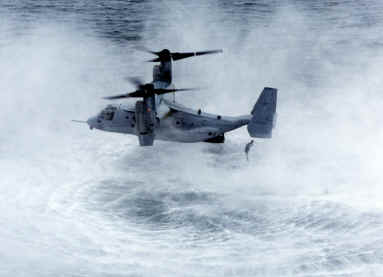 Thanks for the well researched article! One
important item missing in the down wash section: in early testing, exiting
Marines literally had their clothing ripped off their bodies when making a
combat entry approach. So the "exiting" procedure had to be
redesigned. Marines must follow a certain path in order to avoid fighting
naked---this of
course doesn't deal with the critical problem of the direction of hostile enemy
fire!
Thanks for the well researched article! One
important item missing in the down wash section: in early testing, exiting
Marines literally had their clothing ripped off their bodies when making a
combat entry approach. So the "exiting" procedure had to be
redesigned. Marines must follow a certain path in order to avoid fighting
naked---this of
course doesn't deal with the critical problem of the direction of hostile enemy
fire!
David Rucker themark@airmail.net
V-22 software problems cannot be fixed
In your article you state that proper testing can eliminate the V-22s software problems. I disagree; the V-22 is "fly-by-wire", meaning that a computer controls the aircraft, based on input from the pilot. Even with the best computers available today, the calculations which the computer must crunch are just too numerous in the hover mode. The V-22 computer controls two engines/rotors and must deal with changing winds, air temperature, speed, direction, weight, humidity, and air density whenever the pilot moves the stick. As a result, control is often sluggish, sometimes taking several seconds to respond. Sometimes the computer is overwhelmed and crashes, so be it must be reset (e.g. rebooted). If you add the complexities of external loads or turbulence from nearby V-22s or minor pilot errors common at night or in combat zones, the V-22 will often crash from "software anomalies", which is what caused the last crash.
Name Withheld
The Pentagon announced its FY2002 budget plan for the V-22. The planned buy was cut from 16 MV-22 (Marines) and 2 CV-22s (Air Force) to 12 unflyable MV-22s. Since the Air Force resisted pressure to order any flawed CV-22s, it signals they have accepted reality and will drop plans for 50 MV-22s. However, the Bell-Boeing team will get an extra $410 million for R&D to try to "fix" the fundamentally flawed V-22 design, again. Since the procurement cuts total only $231 million, the Bell-Boeing team will make even more profits during FY2002 than if the flawed V-22 had been approved for full production.
Only two V-22s will fit in an LHA Hanger
I'm in the Navy and was on the USS Saipan where the V-22 was certified as shipboard compatible. It was designed to fit in the hanger deck of an LHA or LHD, it does, by inches, which doesn't leave room to move them around. I estimated that we could only fit two in the hanger deck at a time. This probably doesn't sound like a big deal, but it is.
Name Withheld
JSF Assault Version
This may be an impossibly naive question, but would the JSF, with it's
internal bomb bay and vertical lift capability, be, with appropriate
modifications, a possible substitute for for the failed V-22? Barring
that, is it possible to meet the Marine's needs with an aircraft with a frame,
etc, built around the JSF's engine and flight controls?
Taylor Norwitt
Ed. Great idea, I've been thinking about that for years. It couldn't replace a helicopters cargo lift ability, but a few long-range rapid assault jet squadrons would prove valuable. The problem is how to disembark as the downwash from a VTOL jet is too heavy. Perhaps the Marines could be in a cargo pod which slides out the back, or they could exit the top and slide down a long extendable metal slide.